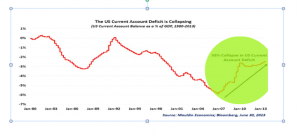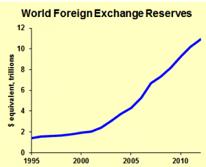In 2014, the US economy took a U-Turn that is set to shape a new world order. The US Federal Reserve (Fed) stopped buying T-Bonds, the US dollar has been rising, the pre-crisis bloated external current account deficit shrank by 58%, and the rate of unemployment is at 5.8 per cent. This picture shows that the global financial crisis , at least in America, is over. Some powerful factors have played in its favor: investments in the oil and shale gas industry, and a shrinking current account deficit, which hit a 16-year low of 1.9 percent of the GDP this year. The effects of the energy boom and cheaper energy (notably natural gas), and the rally in global equities generated by the Fed’s third wave of quantitative easing—which boosted investment income—have aligned to realize the dream of a U.S. manufacturing renaissance—a crowning achievement—which is estimated to cut manufactured imports and boost US manufactured exports.
If these numbers tell a story, it is that the US is making the most of the crisis, fixing its huge pre-crisis imbalances, and rebalancing the economy to pursue a healthier course. Yet, this uplifting story has downsides, which to resort to Andrew Sheng’s words bring to mind the Triffin dilemma.
“The time will come when the US economy shrinks its current account deficit and decreases dollar liquidity, creating a debt-deflation trap for the emerging world. If the leading central banks do not step up to provide compensating liquidity for the rest of the world, which is still growing faster than the advanced countries, then there will be a credit crunch.” (EastAsia Forum 2014).
We are just living that time and a serious question arises over what factors are likely to cause the US to rebalance the global economy, especially for those countries that most rely on the US dollar. A shrinking US current account deficit, a rising dollar matched to a flight-to-quality, and especially a reduction of US dollar exports (petrodollars) are set to reduce the supply of dollars in the global economy.
In economics terms, this signals the Triffin dilemma. The always-useful Wikipedia definition states:
“The Triffin dilemma or paradox is the conflict of economic interests that arises between short-term domestic and long-term international objectives when a national currency also serves as a world reserve currency. The dilemma of choosing between these objectives was first identified in the 1960s by Belgian–American economist Robert Triffin. He pointed out that the country whose currency, being the global reserve currency, foreign nations wish to hold, must be willing to supply the world with an extra supply of its currency to fulfill world demand for these foreign exchange reserves”.
A reduction in the supply of dollars and a stronger dollar value, which are legitimate outcomes of national policymakers, are set to trigger a credit crunch and increase expenses for developing dollar-dependent economies with trade currencies and foreign reserves denominated in US dollars.
Emerging economies, which are still the most dollar-dependent, are set to take the brunt, as they are mostly required to pay for trade transactions in US dollars.
The dollar’s availability is still abundant as the Fed is stuck at a zero rate. Yet a shrinking dollar supply is expected to occur faster than anticipated. Questions arise regarding whether the present international monetary system under the Fed‘s leadership is willing to supply emergency funds at a whopping scale. And should a full-size liquidity crisis develop, where would fresh liquidity come from to keep the world economy going?
The above questions are not negligible, given that emerging and developing economies dependent on the dollar make up more than half of the global GDP. A liquidity crisis could not only hit emerging and developing economies, if it were to materialize, it would clearly cause a global economic contraction.
This gloomy scenario is evidence that the current monetary system is fated to fall under the gyrations of the Fed’s monetary policy once again. Capital flows are still driven by US monetary policy two episodes of swift capital outflows from emerging economies appeared in 2013 and October 2014. Both were triggered by the Fed’s announcements that it would stop buying T-Bonds and raising rates. Capital outflows from emerging economies and even from Europe have flattened yields of US Treasury bonds with the dollar still at zero rate, while spreading up yields on Eurozone periphery bonds will eventually force central banks to increase interest rates in emerging economies.
The classical Triffin dilemma predicts that fixing the problem with an alternative reserve currency is inherently impossible— “my currency, your problem”—and that the only solution is a kind of synthetic “global currency” resulting from a balanced basket of major currencies.
Still, fresh evolutionary dynamics are surfacing in the monetary system that outshine the “global currency” hypothesis. The real world of monetary markets, and even of conservative central bank reserve managers, seem prepared to accommodate the Chinese renminbi (RMB), the new entry from Asia, in order to diversify risks, and in doing so is anticipating the need for a more balanced monetary system distributing risks and opportunities among major reserve currencies.
China’s RMB, also called the “redback,” became one of the world’s top 10 most-used currencies in 2013. By 2020, it will be widely used in international trade and finance.
Indeed, an outcome of China’s approach to internationalizing its currency to promoting its use in settling foreign trade has encouraged its use in cross-border investments. In establishing offshore RMB centers, China’s policymakers have responded to a dearth of US dollars in the middle of the 2008-2009 crisis.
If the move to the internationalization of the RMB was driven by the necessity to keep trade going, in less than three years RMB has overtaken the euro, becoming the second-most used currency in trade finance. A RMB zone seems set to rival the “dollar zone”, which has dominated the post-war monetary system. The boundaries of this new currency area are clear in Asia, where the RMB has emerged as reference currency, and among the BRICS countries (Brazil, Russia, India, China and South Africa), following a decision to create two key entities (the New Development Bank (NDB) and a Contingent Reserve Arrangement (CRA)) designed to form a developing world alternative to the two institutional bulwarks of the “dollar zone”, the World Bank and International Monetary Fund (IMF).
At present, RMB internationalization is a high velocity gear that only depends on China’s policymakers to make of it a global currency. For China, this implies that policymakers will fix the domestic bank-dominated financial system that still depends on politically determined exchange rates and interest rate decisions, and resolving to get rid of financial repression that hampers both domestic demand and private sector financing. As Nicholas Lardy argues for the Administration, lifting financial repression in China would achieve a critical step forward in rebalancing the economy toward domestic consumption. At the same time, with a strong and more sophisticated financial environment, and liquidity and depth to manage volatile exchange rates and capital flows, the RMB could well graduate to a full-fledged reserve currency, helping to fix the current lopsided monetary system.
In conclusion, international dynamics seem very eager and active in welcoming the RMB, as yesterday did the Euro. It’s up to China’s political leaders and international monetary institutions—the IMF for one—to prepare the field and fix the current outdated monetary regime, and drive smoothly toward a more stable multipolar monetary system.
[1] This article draws on the author’s presentation at the Annual Conference “The Internationalization of the Renminbi” 17 October 2014 Organized by the Center for Finance and Development. The Graduate Institute. Auditorium Ivan Pictet. Maison de la Paix. Geneva.


















